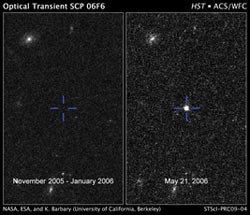Star Light, Star Bright, Its Explanation is Out of Sight

NASA, ESA, and K. Barbary (University of California, Berkeley/Lawrence Berkeley National Lab, Supernova Cosmology Project)
A mysterious flash of light from somewhere near or far in the universe is still keeping astronomers in the dark long after it was first detected by NASA's Hubble Space Telescope in 2006. It might represent an entirely new class of stellar phenomena that has previously gone undetected in the universe, say researchers.
Astronomers commonly observe intense flashes of light from a variety of stellar explosions and outbursts, such as novae and supernovae. Hubble discovered the cosmic flash on February 21, 2006. It steadily rose in brightness for 100 days, and then dimmed back to oblivion after another 100 days.
The rise and fall in brightness has a signature that simply has never been recorded for any other type of celestial event. Supernovae peak after no more than 70 days, and gravitational lensing events are much shorter. Therefore, this observation defies a simple explanation, reports Kyle Barbary of the Lawrence Berkeley National Laboratory (LBNL) in Berkeley, Calif. He is describing the bizarre Hubble observation at the 213th meeting of the American Astronomical Society in Long Beach, Calif. “We have never seen anything like it,” he concludes.
The spectral fingerprints of light coming from the object, cataloged as SCP 06F6, also have eluded identification as being due to any specific element. One guess is that the features are redshifted molecular carbon absorption lines in a star roughly one billion light-years away.
But searches through various astronomical survey catalogs for the source of the light have not uncovered any evidence for a star or galaxy at the location of the flash. The Supernova Cosmology Project at LBNL discovered it serendipitously in a search for supernovae.
Hubble was aimed at a cluster of galaxies 8 billion light-years away in the spring
constellation Bootes. But the mystery object could be anywhere in between, even in the halo of our own Milky Way galaxy.
Papers published by other researchers since the event was reported in June 2006, have suggested a bizarre zoo of possibilities: the core collapse and explosion of a carbon rich star, a collision between a white dwarf and an asteroid, or the collision of a white dwarf with a black hole.
But Barbary does not believe that any model offered so far fully explains the observations. “I don't think we really know what the discovery means until we can observe similar objects in the future.”
All-sky surveys for variable phenomena, such as those to be conducted with the planned Large Synoptic Survey Telescope, may ultimately find similar transient events in the universe.
The Hubble Space Telescope is a project of international cooperation between NASA and the European Space Agency (ESA) and is managed by NASA's Goddard Space Flight Center (GSFC) in Greenbelt, Md. The Space Telescope Science Institute (STScI) conducts Hubble science operations. The institute is operated for NASA by the Association of Universities for Research in Astronomy, Inc., Washington, D.C.
STScI is an International Year of Astronomy 2009 (IYA 2009) program partner.
Media Contact
More Information:
http://www.stsci.edu http://hubblesite.org/news/2009/04 http://www.nasa.gov/hubbleAll latest news from the category: Physics and Astronomy
This area deals with the fundamental laws and building blocks of nature and how they interact, the properties and the behavior of matter, and research into space and time and their structures.
innovations-report provides in-depth reports and articles on subjects such as astrophysics, laser technologies, nuclear, quantum, particle and solid-state physics, nanotechnologies, planetary research and findings (Mars, Venus) and developments related to the Hubble Telescope.
Newest articles

Trotting robots reveal emergence of animal gait transitions
A four-legged robot trained with machine learning by EPFL researchers has learned to avoid falls by spontaneously switching between walking, trotting, and pronking – a milestone for roboticists as well…

Innovation promises to prevent power pole-top fires
Engineers in Australia have found a new way to make power-pole insulators resistant to fire and electrical sparking, promising to prevent dangerous pole-top fires and reduce blackouts. Pole-top fires pose…

Possible alternative to antibiotics produced by bacteria
Antibacterial substance from staphylococci discovered with new mechanism of action against natural competitors. Many bacteria produce substances to gain an advantage over competitors in their highly competitive natural environment. Researchers…





















